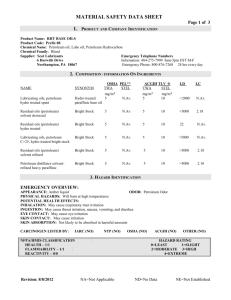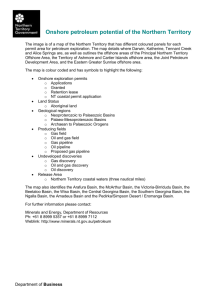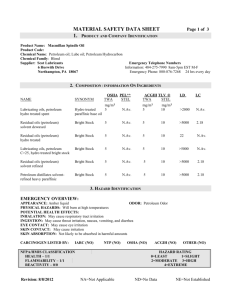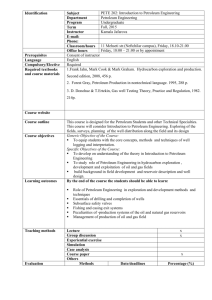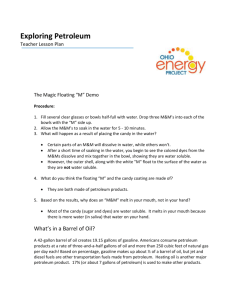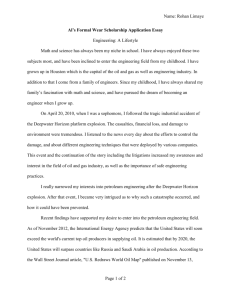Backround
advertisement
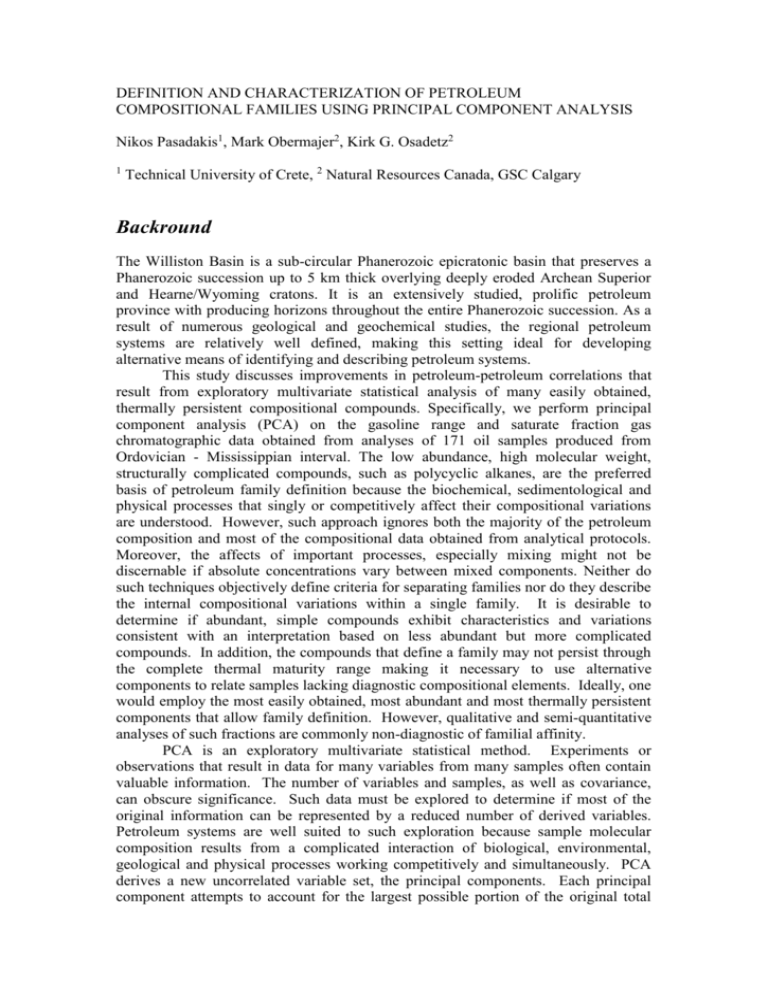
DEFINITION AND CHARACTERIZATION OF PETROLEUM
COMPOSITIONAL FAMILIES USING PRINCIPAL COMPONENT ANALYSIS
Nikos Pasadakis1, Mark Obermajer2, Kirk G. Osadetz2
1
Technical University of Crete, 2 Natural Resources Canada, GSC Calgary
Backround
The Williston Basin is a sub-circular Phanerozoic epicratonic basin that preserves a
Phanerozoic succession up to 5 km thick overlying deeply eroded Archean Superior
and Hearne/Wyoming cratons. It is an extensively studied, prolific petroleum
province with producing horizons throughout the entire Phanerozoic succession. As a
result of numerous geological and geochemical studies, the regional petroleum
systems are relatively well defined, making this setting ideal for developing
alternative means of identifying and describing petroleum systems.
This study discusses improvements in petroleum-petroleum correlations that
result from exploratory multivariate statistical analysis of many easily obtained,
thermally persistent compositional compounds. Specifically, we perform principal
component analysis (PCA) on the gasoline range and saturate fraction gas
chromatographic data obtained from analyses of 171 oil samples produced from
Ordovician - Mississippian interval. The low abundance, high molecular weight,
structurally complicated compounds, such as polycyclic alkanes, are the preferred
basis of petroleum family definition because the biochemical, sedimentological and
physical processes that singly or competitively affect their compositional variations
are understood. However, such approach ignores both the majority of the petroleum
composition and most of the compositional data obtained from analytical protocols.
Moreover, the affects of important processes, especially mixing might not be
discernable if absolute concentrations vary between mixed components. Neither do
such techniques objectively define criteria for separating families nor do they describe
the internal compositional variations within a single family. It is desirable to
determine if abundant, simple compounds exhibit characteristics and variations
consistent with an interpretation based on less abundant but more complicated
compounds. In addition, the compounds that define a family may not persist through
the complete thermal maturity range making it necessary to use alternative
components to relate samples lacking diagnostic compositional elements. Ideally, one
would employ the most easily obtained, most abundant and most thermally persistent
components that allow family definition. However, qualitative and semi-quantitative
analyses of such fractions are commonly non-diagnostic of familial affinity.
PCA is an exploratory multivariate statistical method. Experiments or
observations that result in data for many variables from many samples often contain
valuable information. The number of variables and samples, as well as covariance,
can obscure significance. Such data must be explored to determine if most of the
original information can be represented by a reduced number of derived variables.
Petroleum systems are well suited to such exploration because sample molecular
composition results from a complicated interaction of biological, environmental,
geological and physical processes working competitively and simultaneously. PCA
derives a new uncorrelated variable set, the principal components. Each principal
component attempts to account for the largest possible portion of the original total
variance, using linear combinations of original variables. The first principal
component passes through the centroid of the standardized data set and is oriented to
maximize sample variance using linear combinations of original variables.
Successive principal components explain the largest possible variance while being
orthogonal to the preceding principal component. Successive principal components
explain progressively less of the original variance. The number of derived variables is
equal to the number of original variables. Sample scores describe position in
principal component space and each original variable has loadings that describe their
contribution to each principal component. Mathematically PCA is either the eigenanalysis of the covariance matrix or the eigen-analysis of the correlation matrix,
depending on the preparation of the dataset.
Display of principal component subsets is the selection of a reduced variable
set. Such visualizations illustrate, either characteristics of the data (clustering about a
point in PC space), linear gradients in the data (correlated variations in PC space), or a
non-linear relationship among the samples (horseshoe effect).
This allows
visualization of samples associations and the elucidation of the role and importance of
original variables, based on their loadings. The interpretation of the principal
components requires additional information from models that interpret variable
loadings. It is also possible to refer independent data models and classifications, as is
the case here. Finally, additional samples can be compared to the model using factor
loadings to calculate their sample scores.
Principal Component Analysis (PCA) has many applications to geological
problems. It has been applied to organic geochemistry describing and classifying both
petroleum generation and secondary processes, to identify petroleum families while
characterizing alteration pathways and has been shown to be efficient for the
discrimination of petroleum sources. In this work we use PCA for variable reduction
and classification purposes, maximizing the diagnostic characteristics of both
fractions.
Type II
(Devonian,
Mississippian
& Mesozoic oils)
not studied
Group 2
(Mission Canyon, Bakken)
(Nisku)
Group 3
Type I
(OrdovicianSilurian oils)
23/30
Lodgepole Fm. (L.Miss.)
0.68
1.81 0.41 0.40
Family B
Bakken Fm. (U.Dev.-Miss.)
1.40
4.02 2.55
0.67
Family D
Winnipegosis Fm. (M.Dev.)
0.87
2.11 1.52
0.07
Winnipeg Gr. (M. Ord.)
and Bighorn Gr. (U.Ord.)
1.10
9.07 2.48
0.04
(Madison)
(Winnipegosis)
d/r
Family C
m/l
Source rocks
(Bakken)
Group 4
Critical biomarker criteria
pr/ph
Zumberge, 1983;
Osadetz et al.,
Leenheer &
Williams, 1974
Zumberge, 1987 1992 & 1994
(Duperow)
Group 1
Family A
(Red River)
(Red River)
Generalized familial classification of Paleozoic oils in the Williston Basin (principal reservoirs
in parentheses). Biomarker ratios (average): pr/ph - pristane/phytane; m/l - C 15-19/C 21-25 n-alkanes;
d/r - diasteranes/regular steranes; 23/30 - C 23 tricyclic terpane/C 30 hopane.
SSE
Moose
Mountain
200
300
N
Souris
River
S
USA
NNE
(km )
100
CANADA
0
Chim ney
Buttle
Little Missouri
River
DEPTH (km )
PALEOCENE
0
0
CRETACEOUS
Winnipegosis
1
1
JURASSIC
TRIASSIC
PERMIAN
PENNSYLVANIAN
2
MISSISSIPIAN
Lodgepole
Bakken
DEVONIAN
3
SILURIAN
Yeoman
ORDOVICIAN
4
CAMBRIAN
NESSON
ANTICLINE
Stratigraphic section of Williston Basin, indicating the
main stratigraphic features and position of effective
Paleozoic petroleum source rocks
Location map showing the main geological elements of Williston Basin and the
distribution of petroleum provinces in the study area
Biomarkers
Principal Component Analysis (PCA) has many applications to geological problems.
It has been applied to organic geochemistry describing and classifying both petroleum
generation and secondary processes, to identify petroleum families while
characterizing alteration pathways and has been shown to be efficient for the
discrimination of petroleum sources. In this work we use PCA for variable reduction
and classification purposes, maximizing the diagnostic characteristics of both
fractions.
Oil families
A
C
B
D
Family D
C 34 prom inenc e
C34/C33 hop a ne
2.0
1.5
C 35 prom inenc e
Family A
1.0
Family B
Family C
0.5
0.0
0.5
1.0
C35/C34 ho p a ne
1.5
SFGC
GRGC
15
Lab.no. 1388
Family C
20
pool: Weyburn, SK
reservoir: Madison (Miss)
Ph
Pr
25
Lab.no. 1402
SFGC
GRGC
Family B
pool: Squaw Gap, ND
reservoir: Bakken (Miss)
15
Pr
Ph
20
25
SFGC
GRGC
Lab.no. 1364
15
Family D
pool: Hitchcock, SK
reservoir: Winnipegosis (Dev)
20
25
Pr
SFGC
GRGC
1 - 2,2-dimethylpentane
2 - 2,4-dimethylpentane
3 - 3,3-dimethylpentane
4 - 2-methylhexane
5 - 2,3-dimethylpentane
6 - 1,1-dimethylcyclopentane
7 - 3-methylhexane
8 - 1c3-dimethylcyclopentane
9 - 1t3-dimethylcyclopentane
10 - heptane
11 - methylcyclohexane
12 - toluene
13 - octane
Ph
Lab.no. 3118
15
Family A
pool: Raymond, MT
reservoir: Red River (Ord)
Pr - pristane
Ph - phytane
15 - C15 n-alkane
20 - C20 n-alkane
25 - C25 n-alkane
Pr
Ph
20
25
Representative GRGCs and SFGCs showing typical gasoline range and n-alkane
distributions in each biomarker-defined Paleozoic oil family.
5
4
Scores
Oil families
A C
B D
Family C
PC 2
2
0.4
0.2
nC8
1
0.0
0
-2
Tol
Benz
naphC6
3
-1
X-loadings
0.6
C6
nC6
naphC7
nC7
Fa
m il
C7
yA
D
ily
m
a
F
-3
-5 -4 -3 -2 -1 0 1
PC 1
Family B -0.2
naphC8
C8
2 3
-0.4
4 5 -0.4
-0.2
0.0
0.2
0.4
PC 1
nC6 = hexane/ Sof compounds eluting between 2,2-dimethylbutane and hexane; nC7 = heptane/Sof compounds eluting between 2,2-dimethylpentane and heptane; nC8 = octane/ Sof compounds
eluting between methylcyclohexane and octane; CYC6 = cyclopentane/hexane; CYC7 = (methylcyclopentane+cyclohexane+dimethylcyclopentane)/heptane; CYC8 =
(methylcyclohexane+ethylcyclopentane+1,cis-4-dimethylcyclohexane)/octane; C6 = (dimethylbutane+methylpentane)/hexane; C7 = (trimethylbutane+dimethylpentane+methylhexane)/heptane;
C8 = (dimethylhexane+trimethylpentane+methylheptane)/octane; Benz = benzene/heptane; Tol = toluene/octane.
The GRCM classifies Families A, Band C unambiguously. Family C exhibits a significant PC2
compositional gradient. Family A samples are characterized by an enrichment of gasoline
range n-alkanes, while Families B and C both have abundant branched and cyclic
compounds, but Family C oils is enriched in aromatic compounds and cyclopentane
compared to Family B. Family D oils exhibit a wide variation of all the modelled gasoline
range components, but it is neither as enriched in n-alkanes as Family A is generally, nor is it
as enriched in aromatics and cyclopentane as are about half of the Family C oils. While
Families Band C are distinguishable, together they display a PC2 variation suggesting either
an alteration of Family C controlled by water washing or by significant mixing of pristine
aromatic-enriched Family C oils with aromatic-poor Family B oils. This model cannot alone
distinguish between these two alternatives.
Scores
3
ily
m
a
F
bC7
D
PI 1
0.6
0.4
0
0.2
-1
mil
Fa
yB
Fa
mi
ly
A
PC 2
1
Fa
mil
y
C
2
X-loadings
0.8
-2 Oil families
A
B
-3
-3
0.0
-0.2
C
D
-2
-1
0
PC 1
1
2
dmC5
3
-0.4
-0.5
K1
0
PC 1
0.5
PI I (Isoheptane value) = (2-methylhexane + 3-methylhexane)/sum of 1c3-, 1t3-, 1t2- dimethylcyclopentanes; K1 (Mango parameter) = (2methylhexane+2,3-dimethylpentane) / (3-methylhexane+2,4-dimethylpentane); bC7 (weight % isoheptane) = (2-methylhexane+2,3-dimethylpentane+3methylhexane)*100 / Sof compounds eluting between 2-methylhexane and 2,2-dimethylhexane; dmC5 = 2,4-dimethylpentane/2,3-dimethylpentane.
The GRRM provides an improved characterization of Family D samples, but it is weaker than
the GRCM at discriminating Family B from Family C in PC1 vs. PC2 space. A strong gradient
among the four families is controlled by the loadings of both K1 factor and the branched to
total C7 compound ratio. This demonstrates that the K1 factor is primarily a source indicator
contrary to the initial interpretation of this parameter. An important feature is the sub-parallel
orientation of the four familial gradients indicating linear variations within each family. The
similarity of these gradients suggests that there is a single dominant process that affects these
internal linear variations. Since the observed gradients are strongly controlled by Paraffin
Index 1 (PI 1) loadings, that process is inferred to be thermal maturity. The almost orthogonal
relationship between the loadings or PI 1 and the K1 factor suggests little impact of thermal
maturity on the K1 parameter, further showing that K1 is an effective source indicator.
Scores
2
ily
m
a
F
0
C
C16
A
-2
Ph
C20-24
C19
-0.2
Oil families
A
C
B
D
PC 1
Pr
C18
0.0
-4
-6 -5 -4 -3 -2 -1
C14
C13
Family D
Fam
ily
PC 2
C15
0.4
0.2
-6
X-loadings
0.6
B
C17
0
1
2
3
4
-0.4
-0.4
-0.2
0
0.2
PC 1
Pr = pristane normalized to the highest peak; Ph = phytane normalized to the highest peak; nC13 to nC24 = C13 to C24 normal alkanes normalized to the
highest peak.
Although oil fam ilies generally exhibit distinc tive ranges of sam ple sc ores within the SFCM, this
m odel is less effec tive in separating fam ilies B, C and D. The results are c onsistent with
predominanc e of lower m olec ular weight odd c arbon num ber n-alkanes in Family A oils that
varies with thermal m aturity. The general tendenc y for Family C oils to have the m ost negative
PC1 sc ores indic ates lower relative c onc entration of Pr and m ore abundant even c arbon
num bered n-alkanes, c om pared to Fam ily B sam ples. This is c onsistent with a lac k of water
c olumn anoxia during deposition of Bakken sourc e roc ks c ompared with signific ant water
c olumn anoxia during the deposition of Lodgepole sourc e roc ks. It is apparent that gasoline
range c om positional differenc es in Fam ily C are ac c om panied by non-linear variations of
sam ple sc ores of SFGC c om ponents. The non-linear relationship among Fam ily C desc ribes a
c ontinuous c om positional variation, but the two orthogonal lim bs provide basis for subdividing
this fam ily into two subgroups. The subgroup with strongly negative PC1 sc ores inc ludes
sam ples enric hed in benzene and toluene, while the sam ples with m ore positive PC1 sc ores
are depleted in these c om pounds and overlap with arom atic -poor Family B oils. While
different proc esses m ight explain these internal Fam ily C variations (water washing,
biodegradation, c om positional m ixing or their c om bination) a m ixing hypothesis is the m ost
plausible explanation. The PC1 and PC2 sc ores of Fam ily D samples overlap those of fam ilies B
and C, not allowing a mutual distinc tion of these samples. Fam ily D sc ores also exhibit a nonlinear variation. Although there are insuffic ient num der of Fam ily D sam ples to c onfirm subc om positions, the sim ilarity to the non-linear behaviour of Fam ily C suggests sim ilar proc esses
m ay be responsible for those variations.
X-loadings
Scores
3
Family B
2
0.4
0
0.2
ily A
Fam
PC 2
1
-2
Pr/C17
CPI(22-32)
Family D
-1
Pr/Ph
0.6
Family C
Ph/C18
0.0
CPI(14-20)
Oil families
A C
B D
-0.2
-3
-3
-2
-1
0
1
PC 1
2
3
4
5
-0.4
-0.2
0
0.2
0.4
0.6
PC 1
Pr/Ph = pristane/phytane ratio; Pr/nC17 = pristane/C17 normal alkane ratio; Ph/nC18 = phytane/C18 normal alkane ratio; CPI 14-20 =
½{[(C15+C17+C19)/(C14+C16+C18)] +[(C15+C17+C19)/(C16+C18+C20)}; CPI 22-32 = ½{[(C23+C25+C27+C29+C31) / (C22+C24+C26+C28+C30)]+[(C23+C25+C27+C29+C31) /
(C24+C26+C28+C30+C32)]}.
In this model the gradient of Family A is distinctive, but its range cannot be attributed only to
differences in thermal maturity, since this gradient is associated with original variable loadings
commonly attributed to source rock depositional environment, such as Pr/Ph. More
noticeable are the two general gradient trends between the Ordovician-sourced and
Devono-Carboniferous sourced oils controlled by the loadings of Pr/C17 and the CPI for the
light n-alkanes. The orthogonal gradient of Family D samples suggests that the composition of
that oil family is affected by factors other than the source kerogen and thermal maturity
variations that account for the internal variation of oil family composition in this and previous
models. The distinction between Family B and Family C samples is controlled by the loadings
of the Pr/Ph ratio and the heavy n-alkane CPI. Both these are commonly interpreted as
indications of source rock depositional environment. Compared to previous models, this
model illustrates distinct and characteristic samples scores for these two families. If only
mixing of Family C and Family B end-members was ubiquitous process responsible for the
variation of Family C scores and their overlap with Family B, then a more significant overlap of
sample scores in the SFRM might have been expected.
Scores
4
0.4
X-loadings
Pr/Ph
Pr/C17
Family B
0.2
PC 2
2
Fami
0
Family A
ly D
Ph/C18
0.0
CPI(14-20)
nC7
-0.2
nC6
-2
Oil families
A C
B D
Family C
-4
-4
-2
0
PC 1
2
-0.4
-0.6
4 -0.4
Benz
Tol
-0.2
0
0.2
0.4
PC 1
Pr/Ph = pristane/phytane ratio; Pr/nC17 = pristane/C17 normal alkane ratio; Ph/nC18 = phytane/C18 normal alkane ratio; CPI 14-20 =
½{[(C15+C17+C19)/(C14+C16+C18)] +[(C15+C17+C19)/(C16+C18+C20); nC6 = hexane/ Sof compounds eluting between 2,2-dimethylbutane and hexane; nC7 =
heptane/Sof compounds eluting between 2,2-dimethylpentane and heptane; Benz = benzene/heptane; Tol = toluene/octane.
The CGSM is useful for the classification of families A and B, and for distinguishing one of either
families C or D in the absence of the other. Family A oils are distinctive and exhibit the smallest
internal variation in the PC1-PC2 space, due primarily to source. A similar source emphasis is
seen in families Band C. If the internal range of individual family PC1 scores is typified by Family
A then the range of PC1 scores of families B and C would be overlap, with or without mixing.
Therefore PC1 compositions of these two families are likely due to source. Family D PC1 scores
likely reflect a progressive change in source paleodepositional conditions during the open
marine to mesohaline basin transition. Therefore, these scores are interpreted as indicating
changes in water column chemistry, specifically oxygenation and salinity, acting on
differences in biomass. This is consistent with previously observed variations between families B
and C, where the two were interpreted to have com positions indicative of dyserobic and
anaerobic water columns, respectively. PC2 scores, controlled by the loadings of benzene
and toluene, and Pr/Ph, define a gradient between families B and C that is at least partly
attributed to mixing.
5
3
Model 1
Model 2
4
2
3
2
1
PC 2
1
0
0
-1
-1
-2
-2
-3
-4
-8
0.8
-6
-4
-2
0
2
4
-3
-3
5
6
Model 4
-2
-1
0
1
2
3
4
Model 5
4
0.6
3
PC 2
0.4
2
0.2
1
0
0
-1
-0.2
-2
-0.4
-3
-0.6
-0.8
-0.4
0.0
0.4
-4
1.2 -4
0.8
-2
0
PC 1
2.0
Model 4
1.4
1.8
0.4
1.2
1.6
Ph/nC18
CPI (14-20)
1.0
b e nze ne
1.6
Model 4
Model 1
0.6
1.4
1.2
1.0
1.0
0.8
0.6
0.4
0.2
0.8
0.2
0.0
0.6
0.0
-4
-2
0
PC 1
2
4
4
PC 1
1.2
0.8
2
-2
0
2
PC 1
4
-2
0
2
PC 1
4
6
Summary
- Gasoline range and >210oC boiling point saturate fraction hydrocarbons carry
important petroleum system information affected by multiple processes
simultaneously complicating compositional traits and limiting their independent value
for classification and interpretation.
- Principal components of these two fractions, interpreted separately or in
combination enhance the interpretation of petroleum systems, especially when
combined with information from biological marker compounds.
- In Williston Basin compositional variations of these fractions follow polycyclic
terpane and sterane biomarker compositional characteristics interpreted previously as
indicative of source rock and thermal maturity characteristics, but herein related to a
more complicated set of processes.
- Only Family A oils, from Ordovician sources, have sufficiently distinctive
compositions to be classified using reduced variable sets from principal component
compositional analysis of these fractions. Families B, C and D oils, from GivetianTournaisian source rocks, also have characteristic compositions of these fractions, but
the range of compositional variations precludes their use as a primary classification
tool. Consideration of multiple models, pair-wise models and additional derived
variables can minimize ambiguities. Pair-wise discrimination using multiple models
assists the identification of families B, C and D.
- Principal component models of both the group of Williston Basin oils and the
individual biomarker-defined families exhibit linear and non-linear compositional
variations that are interpreted using variable loadings and independent information to
result from: kerogen composition, compositional mixing, source rock depositional
environment, and thermal maturity
- Despite their lack of diagnostic capability for familial classification, these fractions
can be better indicators for certain processes, such as compositional mixing - as
shown here particularly - than more complicated compounds present in lower
abundance. Therefore, the classification and analysis of petroleum systems can
benefit from a combination of biological marker analysis and principal component
analysis of gasoline range and >210oC boiling point
Leenheer, M.J., Zumberge, J.E., 1987. Correlation and thermal maturity of Williston Basin crudeoils and Bakken source rocks
using terpane biomarkers. In: Longman, M.W. (Ed.), Williston Basin: Anatomy of a Cratonic Oil Province. Rocky
Mountain Association of Geologists, Denver, pp. 287-298.
Obermajer, M., Osadetz, K.G., Fowler, M.G., Snowdon, L.R., 2000. Light hydrocarbon (gasoline range) parameter refinement
of biomarker-based oil-oil correlation studies: an example from Williston Basin. Organic Geochemistry 31, 959-976.
Osadetz, K.G., Brooks, P.W., Snowdon, L.R., 1992. Oil families and their sources in Canadian Williston Basin, (southeastern
Saskatchewan and southwestern Manitoba). Bulletin of Canadian Petroleum Geology 40, 254-273.
Osadetz, K.G., Snowdon, L.R., Brooks, P.W., 1994. Oil families in Canadian Williston Basin southwestern Saskatchewan.
Bulletin of Canadian Petroleum Geology 42, 155-177.
Williams, J.A., 1974. Characterization of oil types in Williston Basin. American Association of Petroleum Geologists Bulletin
58, 1243-1252.
Zumberge, J.E., 1983. Tricyclic diterpane distributions in the correlation of Paleozoic crude oils from the Williston Basin. In:
Bjoroy, M. (Ed.), Advances in Organic Geochemistry 1981. John Wiley & Sons Ltd., New York, pp. 738-745.
We thank Sneh Ac hal & Laura Mulder, GSC-Calgary, for exc ellent tec hnic al
assistanc e. The Saskatc hewan Geologic al Survey and various oil c ompanies are
thanked for providing selec ted oil samples.

